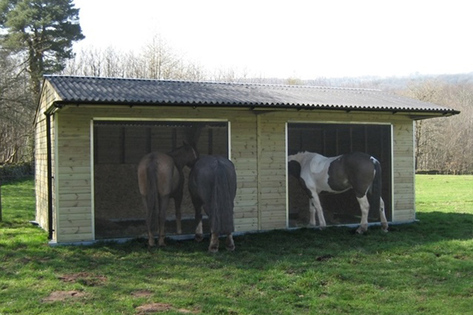
Are You & Your Horse Ready For Bitting Advice? The Steps You Need To Consider First
Equestrian Advice & Guides All Disciplines
Build your business profile for FREE and expose your services to thousands of potential clients!
Create my profile now!
With the changing seasons, yard owners are increasingly looking to improve their facilities and to ensure the equines in their care can remain comfortable, whilst being able to protect themselves from hot or inclement weather. Many yard owners are turning to field shelters, either in the form of smaller shelters for individual or small herd turnout, or larger barn style shelters for bigger herds.
You would think that picking a field shelter would be an easy task, but with so many options on the internet, it is easy to get in a muddle. A field shelter should be in place to ensure horses are comfortable in their paddock year-round, whatever the weather, enabling them to shelter from wind and rain, and to find a shady spot in the summer sun.
If you are in the market for a new field shelter, we suggest considering the following advice from Matthew Pike of Jon Williams Stables to ensure your horses have a safe and comfortable field shelter that you’ll find easy to maintain and enjoy.
Selecting Your Field Shelter Location
When deciding where to place your field shelter, you should consider which way the wind blows. It will be there to provide shelter after all, so you need to ensure the shelter has it’s back to the prevailing wind so your horses are protected from the elements.
If possible, you should also place the shelter on the highest point. Never place a shelter at the bottom of a hill or in a dip as this can result in standing water, water damage to the shelter and the potential for the shelter floor to be muddy during times of heavy rainfall. You should also consider keeping the shelter away from overhanging trees - the limbs can damage the roof and disturb the horses in stormy weather.
You should also ensure that you do not place your shelter right against the boundary if there is a soft boundary in place such as hedges, and ensure it will not encroach on any space needed in gateways or in the corner of fields. You need to ensure that there is enough space between the boundary and the shelter to prevent a horse getting trapped, and you should also be able to access the boundary for maintenance - such as fence repair or cutting back of hedges or trees, should this be necessary.
What Size Field Shelter?
The size of field shelter you will need depends on how many horses you have and if you plan to keep any supplies in the shelter. As each yard owners’ needs are different, it is recommended to create a bespoke shelter to fit your exact needs. Jon William Stables suggests a general guideline for sizes of field shelters:
If you want a dual-purpose field shelter, you could also consider adding on extras such as a locked area for feed or equipment, or separate sections for storage. This can save a yard owner time by having everything they need to hand in the shelter, rather than having to carry headcollars, feed or haynets to the field in a wheelbarrow!
Mobile Or Static Field Shelter?
Stationary shelters will usually require planning permission. This can often be a costly and lengthy process with no guarantee that permission will be granted. Because of this, mobile shelters are becoming more popular because they do not need planning permission, and they have the flexibility of being moved around the paddocks, or even from paddock to paddock or elsewhere on the yard, as required.
The ability to move a shelter can also be advantageous should you choose to alter the layout of your paddocks, and can even allow you to move the shelters according to the seasons to provide the best possible shelter for the horses.
However, it should be considered that mobile shelters should be just that and many local authorities may consider a field shelter permanent if not moved regularly, or if situated on a permanent base such as a concrete pad. It is well advised to check with your local authority as to their planning requirements before opting for either a mobile or static field shelter to ensure you do not risk breaching planning laws.
Double Up As A Stable
Many field shelter designs can also lend themselves to double up as a mobile stable should this be required. The simple addition of a front gate and/ or partitions can allow for a field shelter to easily be turned into an enclosed stable. This is especially useful for horses who live out but may require stabling in the event of severe weather, injury or isolation. However, do bear in mind that the change of a field shelter to a stable on a long-term basis may change the planning status of the building.
You can have the necessary fixtures - such as hinges - placed on the field shelter during construction, with the stable elements easily stored and then fitted as required. You should ensure that any elements used to turn shelters into stables should be safe and suitable for containment such as high-quality galvanised-steel boarded gates or slide rails.
In such situations where a shelter may be used as a stable, it would be worth considering the ability to separate a larger field shelter using partitions which can allow for stabling of more than one horse, as well as the potential to add on a secure storage area for tack, feed or equipment. This can be particularly advantageous for owners who have their horses living out 24/7 on livery to offer them their own or shared shelter with attached storage, reducing the need for their storage on the yard or their need to access communal areas.
Build To Last
Although there are many ‘basic’ field shelters on offer, if you are investing in a piece of equipment for your yard, you should make sure it meets your requirements and is a sound investment. Lower priced shelters can often be reflected by lesser quality materials or build quality. You should look for good quality, treated wood, with a solid construction. You should request the specification of any shelters you are considering and compare like for like with other brands. Ensuring good build quality and longevity of materials is just the first step. Being outside 24/7 a shelter is susceptible to all types of weathers from torrential rain to extreme summer heat so you need to ensure your shelter can withstand all of this and is built to last.
When looking into the specifications of your shelter and who you want to buy from, you should consider a few things to make sure you are getting great value. What is the construction process? Who will be building the shelter? What type of roofing will be used? What fixings are used? Is a canopy provided, will there be kickboards? Is the wood treated to prevent against rot or decay? For a quick overview of what you should expect of a high-quality shelter that will last, take a look here.
Whilst a field shelter may not be as big of an investment as a barn or stables, it is still an investment that should stay in good shape for many years to come. Some additional features that you could consider to promote the longevity of your shelter, or to improve its usability are:
These are the just some features suggested by Jon William Stables for mobile and static field shelters, which are just some of the products they offer. However, the bespoke features are endless! It is worth looking at previous constructions for inspiration and ideas. What once started as an idea for a basic field shelter could become something much more useful to you in the long term by way of simplifying the management of horses in your care.
LiveryList is the UK’s #1 Livery Yard Directory and Yard Owner Resource, and has a huge number of documents and resources available for yard owners on the LiveryList Yard Owner Hub, including a specific section on Facility Planning and Management where you can download this guide as a handy PDF here - ‘Choosing and Constructing Field Shelters for Your Yard’
With hundreds of horse owners looking for a new yard every week, yard owners can advertise their Livery Yard and their vacancies on LiveryList from just £12 a year.
LiveryList also runs the Livery Yard Owners UK- Discussions and Advice Facebook group. A closed group especially for verified owners across the UK, it is a friendly and welcoming group allowing yard owners to discuss and share advice, as well as network with other yard owners in their area.

